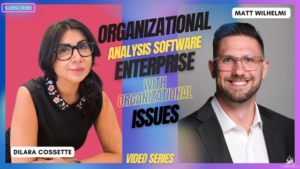Abha DasGupta of Stratvy: An EdTech Company Failing to Grow ARR
Abha DasGupta of Stratvy: An EdTech Company Failing to Grow ARR
Abha DasGupta and Matt Wilhelmi – Episode 1
Growing an EdTech SaaS organization from $50M to $75M in two years or less is an exciting journey. Joined by Abha DasGupta, founder and CEO of Stratvy with an MBA from American University specializing in Information Systems and Marketing and over 25 years of leading tech based organizations as both a president and CEO, Matt Wilhelmi helps to unpack this case study.
The founder initially thought the problem was product. Abha outlines her approach to uncovering the root causes that were causing sales to plateau.
In this episode, you’ll discover: The Intersection of EdTech and FinTech: Dive deep into the similarities and distinctions between EdTech and FinTech industries, focusing on ARR models, monetization strategies, and the importance of value propositions.
- Strategic Engagements and Outcomes: Learn about the different types of engagements Abha undertakes, from short-term strategic facilitations to long-term roles like Fractional Chief Strategy Officer, and how these help companies identify and achieve their growth objectives.
- Case Study Exploration: Hear a real-life example of how Abha helped an EdTech company focusing on higher education software to redefine its growth strategy, improve product offerings, and enhance market positioning.
- Core Challenges and Solutions in Scaling: Understand the typical issues companies face when scaling and how Abha addresses these through comprehensive market analysis, defining customer journeys, and strategic problem-solving.
Specializing in EdTech and FinTech SaaS organizations post series A or series B funding, Abha DasGupta demonstrates her masterful ability to balance both relating to founders’ issues, worries, and concerns, while providing them with strategic and actionable advice they can choose to share with their teams, their boards, or keep to themselves.
Referencing product development, which causes many founders to lose sleep due to worry or neverending improvement processes, Matt presents an analogy of artists and knowing how much paint is enough paint to put on a canvas. It’s the same when you’re working with an industry veteran like Abha DasGupta.
Abha DasGupta and Matt Wilhelmi – Episode 2
SaaS Cautionary Tales with Abha DasGupta is where we unpack some of those stories where clients maybe don’t take our advice, don’t execute in a timely manner, or choose to go a different route and then we analyze what happens. In this episode, Abha and I unpack three not so unique cautionary tales from our time in working with SaaS organizations.
The first story we delve into is a common issue many founders face. Essentially, they spend way too much time focused on developing their product and making sure it’s perfect before getting it out into the market to get feedback. Abha shares some issues this presents and ultimately presents the ideal solution; settle for 80%. How do you do this? With an MVP (Minimum Viable Product) to get feedback and market acceptance.
In the second story, Matt tells of his time in working with a Radio Station that had actual pictures of their ideal client personas posted on the walls to remember who they’re talking to each day. Matt goes on to talk about a concept he wrote about in his book, Taboo Business Questions. The concept is of an Ideal Circumstance Paradise. This is the perfect situation where your ideal client persona will always buy your product or service. This is where you want to spend your time and money in marketing.
Abha shares a cautionary tale of a SaaS company that figured out they were targeting the wrong person within an organization. Essentially, the administrators were interested and wanted the software, but they weren’t the decision makers. So, she had to work with the sales team to better understand who the marketing should be more geared towards.
When these issues aren’t figured out and solved, they often create rippling effects within the organization. It’s not just the churn that is important to consider, it’s also the frustration of the team in trying to support clients that maybe aren’t the best fit. It’s also taking time and resources away from gaining new and exciting clientele.
Abha DasGupta and Matt Wilhelmi – Episode 3
Abha DasGupta, founder and CEO of Stratvy, joins Matt Wilhelmi to discuss the results of a case study where a B2B SaaS company had a great product developed but it wasn’t selling as well as expected in the market.
Abha explains her consultative approach to really understand the root issues the organization was facing and then provides a summary of the solutions presented. Specifically, she was able to develop a go to market strategy that helped with demand generation activities and addressed the marketing mix. She was able to help the sales team identify that their sales presentation wasn’t quite on point. After a few tweaks, they were able to increase retention from 80% to over 98%!
She developed Objectives and Key Results for each step of her engagement with the organization over the 3, 6, and 12-months she supported this growth tract.
Matt expressed the excitement of his analytical nature in hearing about the metrics. The utilization numbers went up. The dashboards gave transparency and visibility into the fine details of the process that gave everyone involved confidence that Abha was turning things around. She implemented the MEDDIC Sales methodology and helped the organization achieve 25% Year over Year ARR growth.
This is a power packed case study you won’t want to miss.





